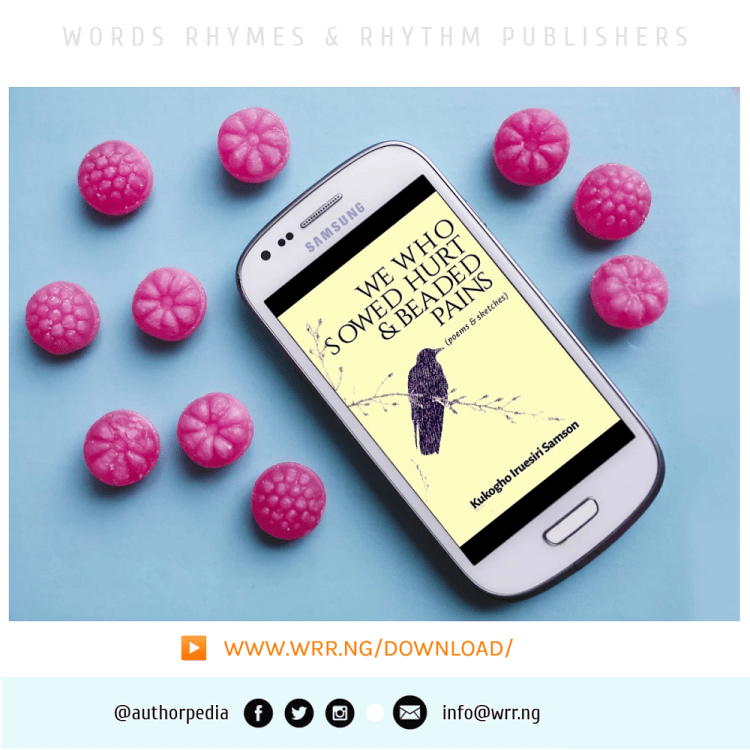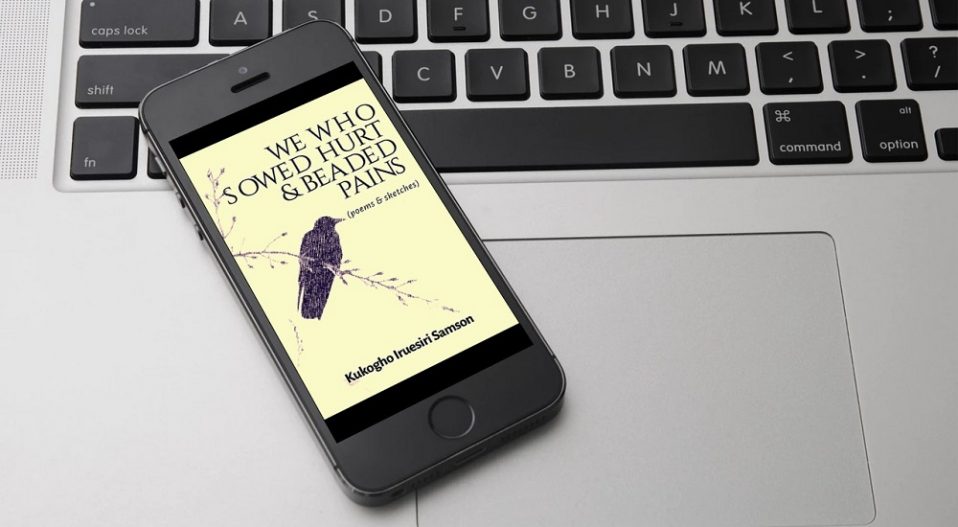Title: We Who Sowed Hurt and Beaded Pains
Author: Kukogho Iruesiri Samson
Genre: Poetry
Number of Pages: 66
Publishers: Words Rhymes & Rhythm
Year of Publication: 2017
ISBN: 978-978-961-655-8
Reviewer: Eugene Yakubu
For readers who are inclined to evoke didactic moral lessons from poetry, the central theme of Kukogho Iruesiri Samson’s collection of poems We Who Sowed Hurt and Beaded Pains is that there is always a hidden personality in every man, a concealed frown in every smile, and a bitter mask in every laughter.
Kukogho’s poems are sure to teach us that the serpent lies under the finest of roses too. Hence, appalling poems like A Grown Man’s Tears, I know a Man who Cries with his Fists, They call it Suicide and so many other sullen poems seemed to teach readers that of all the hideous of devils, the one true wretch that nobody ever wants to give any credence to is the one living behind the pleasing outward facade we sell out to the world.
At least for the poet, physical charm, joy and happiness do not necessarily equate to personal happiness. Hence, there are dozens of people strutting the street but carrying depressive explosives in their hearts and prone to explosion anytime.
This is poetry that dared to divorce the stale traditional popular theme of sociopolitical discourses and embrace issues of identity, desire and psychological trauma— a timely effort in this contemporary world. This collection of poems is charged with subtle messages on psychic disorders and traumatic identities in that the poet chose to base his theme around depression and mental trauma. Be that as it may, despite the grave tone and thunderous rhythm in the poems; the poet still yet never abandoned his stylistic grandeur and literary efficacy.
The collection is gracefully adorned in chunks of similes, metaphors, rhetorical questions, personifications, irony and symbols. The diction is carefully chosen to have affective effects on readers.
In the poem l.o.v.e, Love is being referred to in personification, clothed as an animate figure to create enduring mental images in the reader. For example, in a witty and creative manner, the poet proffers that:
“if you see love strolling like a dreaded ragamuffin
with locks dangling from a rainbowed hat”.
This description practically creates picturesque memories in the reader’s mind and dragged him into the poet’s own mind as he scribbles from his thought.
This collection is commendable for its venturous glide into the psychology of the depressed. The poet conquered the blockading fog that most traumatic victims and depressed people are known to have cocooned themselves into— living in their souls, away from society’s eyes. But, even so, the poet manages to capture the psychology of depression as it affects people and even offers various signs that point at advent of a psychological tumult. For the Poet, in the poem They call it Suicide, he sees the depressed person as withdrawing into himself, away from public stare “like a sprinting snail touched on the nose”.
It was Sigmund Freud who said that “for an external frustration to be pathogenic, an internal frustration must be added to it”.
This the poet knows in that he formed his victims of depression to have been under an earlier traumatic occurrence which then instigate their present chaotic thoughts. This is captured in the poem They Called it Suicide, whereby the poet wrote that:
“the tiny sparks, they ignited tiny flames
and the tiny flames, they became fireballs
slowly eating the pages of his troubled mind”.
The poet is a moralist with an ardent bidding to correct the flawed attitude of the society towards ostracized people. In the same poem, the poet marveled at the indifference of the world to the scourge of depression and the carefree attitude of people towards overly introvertish personality which the society choose to call “metamorphosis”, but until the victim finally give up on life and robed his neck on a branch, then people quickly criticize and label it “suicide”.
The poet didn’t totally abandon the social issues in his society. In the poem 3rd Mainland Bridge, the poet makes a creative allusion to the trending suicidal acts happening in the popular 3rd Mainland Bridge in Lagos. The poet used this background to recount the gory situation through his poems, as such mirroring the society in which he lives— a basic attribute of literature.
WE WHO SOWED HURT & BEADED PAINS (2ND EDITION) BY KUKOGHO IRUESIRI SAMSON
The poet’s diction is renowned for its ability to transpose the reader and create in him a trance- like effect whereby he envelops himself in the pages of the book, in the words and by so doing in the poet’s thoughts too. The diction reveals strikingly expressive images.
In I am Looking for My Childhood, the poet in the last line of the fourth stanza referred to his knock as “soft- knuckled and softhearted”, a connotation which practically reveals the child- like nature and innocence of the poet- personae. He also described a depressed mind as “iced fire curdling his blood into a lumpy dirge”.
This mastery with words nonetheless offers the reader the opportunity to see and realize virtually every meaning and theme immersed in language. The poet laudably assumed to himself a liberty with words which is only evident in the most sophisticated of poets.
He departed from the rules and conventions of standard spoken and written prose in matters such as syntax, word order, the use of archaic and newly coined words; which fortunately is literarily doable and permissible— technically termed as poetic license. The poet was spontaneously free to violate language for special effects which of course freshens our perceptions both of literary language and of the world it represents.
In I am Looking for my Childhood, the poet amusingly uses newly coined words like “longa- throats”, “rainbowed”; in teach me how to be sad he used “unteach”; “unbirthed” in song from my soul; and in the titled poem lie- f to convey his personal thoughts and unique predilection— a rare feat in African poetry.
This poetry collection is sure to tell every reader a piece about his life. It has strikingly refreshing poems as well as meditative verses that transcend minds into nebulous realms for a peaceful re-connection with the soul.
The witty poem with a promising title Happiness is Sand in a Hourglass is a must- read for all readers, likewise the succinct and efficient verse My Cross which says everything about contentment. The motivational verse People Never Understand is trigger that pushes the best part of an individual to just live his life, it teaches that people are not ever going to understand; hence one should live his life to his best.
Concealed behind this captivatingly promising title We Who Sowed Hurt and Beaded Pains is the sublime thoughts of a brave poet who risked stepping out of the status-quo and familiar notions of poetry and enormously succeeded in telling and schooling the reader about much that is worthy of consideration.
This book is a must- read for all lovers of good literature and is recommended for a psychological appraisal by psychoanalytic readers to uncover the somber mood, sullen diction and meditative tone of the poet.







You must be logged in to post a comment.